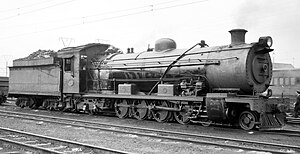4-8-2

Front of locomotive at left
|
|||||||||||||||||||

NGR Hendrie D, the first true Mountain locomotive
|
|||||||||||||||||||
|
|||||||||||||||||||
|
|||||||||||||||||||
|
|||||||||||||||||||
|
|||||||||||||||||||
| Equivalent classifications | |
|---|---|
| UIC class | 2′D1 |
| French class | 241 |
| Turkish class | 47 |
| Swiss class | 4/7 |
| Russian class | 2-4-1 |
| First known tank engine version | |
|---|---|
| First use | 1888 |
| Country | Colony of Natal |
| Locomotive | NGR Class D, Dübs A |
| Railway | Natal Government Railways |
| Designer | William Milne |
| Builder | Dübs and Company |
| First known tender engine version | |
|---|---|
| First use | 1906 |
| Country | Colony of Natal |
| Locomotive | NGR Altered Class B |
| Railway | Natal Government Railways |
| Designer | D.A. Hendrie |
| Builder | Natal Government Railways |
| Evolved from | 4-8-0 modified |
| Benefits | Improved stability at speed |
| First known "True type" version | |
|---|---|
| First use | 1909 |
| Country | Colony of Natal |
| Locomotive | NGR Class Hendrie D |
| Railway | Natal Government Railways |
| Designer | D.A. Hendrie |
| Builder | North British Locomotive Company |
| Evolved from | 4-6-2 |
| Benefits | Wide and deep firebox behind coupled wheels |
Under the Whyte notation for the classification of steam locomotives, 4-8-2 represents the wheel arrangement of four leading wheels, eight powered and coupled driving wheels and two trailing wheels. This type of steam locomotive is commonly known as the Mountain type.
The tank and tender locomotive versions of the 4-8-2 Mountain wheel arrangement both originated in the Colony of Natal in South Africa.
In 1888, the Natal Government Railways (NGR) placed the first five of its eventual one hundred Class D 4-8-2 tank locomotives in service. The locomotive was designed by William Milne, the Locomotive Superintendent of the NGR from 1877 to 1896, and was built by Dübs and Company. This was the first known use of the 4-8-2 wheel arrangement in the world.
In 1906, six NGR Class B 4-8-0 Mastodon locomotives, designed by D.A. Hendrie, NGR Locomotive Superintendent from 1903 to 1910, were modified to a 4-8-2 wheel arrangement by having trailing bissel trucks added below their cabs to improve their stability when hauling fast passenger trains. These altered Class B locomotives were the first 4-8-2 tender locomotives in the world.
The first locomotive to be designed and built as a 4-8-2 tender locomotive was New Zealand’s X class, designed by A. L. Beattie and built by the New Zealand Railways Department's Addington Workshops in Christchurch in 1908. It was designed to haul heavy freight trains on the mountainous central section of the North Island Main Trunk Railway and it is believed that this was the source of the "Mountain" name of the 4-8-2 type, although it is also possible that the name was originated by the Chesapeake and Ohio Railway in the United States of America, who named the type after the Allegheny Mountains. The X class was, however, not considered to be a true Mountain type, since its trailing truck served to spread the axle load rather than to allow a larger and wider firebox. The trailing wheels were positioned well behind a narrow firebox, which itself sat above the coupled wheels, necessitating the same design compromise between coupled wheel diameter and grate size as on a 2-8-0 Consolidation or 4-8-0 Mastodon. A true 4-8-2 design was a progression of the classic 4-6-2 Pacific layout, which featured a wide firebox positioned above the trailing truck and behind the coupled wheels, allowing for a wide and deep firebox as well as large coupled wheels.
...
Wikipedia
